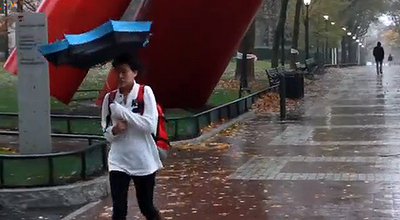The Lackluster Year that was Cannes 2010 and Why Audiences Were Leaving the Theaters
Yesterday, I introduced Chloe Castellon (C’11), our special Penn in Cannes DT correspondent for the 2010 Cannes Film festival.
Today, Chloe give us scoop on:
- the winning films that kept her on the edge of her seat
- the “bitterly disappointing” films she saw
- and the surprisingly overall poor selection of films for this year’s festival.
…And find out why “Chubaka–look-alike ‘monkey ghost’ sex” drove audiences out of the theaters in mass exodus! This is classic!
More from Chloe after the jump…
>”Overall, the films competing at Cannes this year were fairly lackluster. Many critics left mid-festival in protest of how the festival was being run, and many more criticized this year’s selection both before and during the actual festival. The titles chosen were thought of as boring, poorly done art-house films with little in the way of innovation, and far from masterpieces. One sound expert in the industry who teaches at New York University even commented that some competition films wouldn’t pass her classroom assignments. Moreover, the jury selection itself for the main competition was fiercely criticized, headed by Tim Burton, who had just sold his soul for commercial success with Alice in Wonderland
and A Christmas Carol, films torn apart by critics, and filled out with the likes of Kate Beckinsale, a fairly mainstream actress who has yet to be nominated for an Oscar, the head of an Italian film museum, and a French composer. The Palm D’or winner might have been chosen because the director was from Thailand and the one saving grace of this year’s selection was its cultural diversity. Or perhaps it was the sheer fact that not too many critics had seen it since it premiered on the second to last day of the festival when the dailies had already packed up their tents. Beggars had extraordinary luck getting into the film because the buzz was so negative that no one wanted to see the second screening, and each beggar would have at least two tickets after setting foot in front of the Palais.
The actual screening of Uncle Boonmee Who Can Recall His Past Lives, complete with Chubaka–look-alike ‘monkey ghost’ sex and a ten minute opening sequence of a bison-like creature running through the forest, incited mass exodus halfway through, among boo’s and derisive laughter. In fact, many competition films saw at least a quarter of the audience leave before the halfway mark. Out of twenty-three films that I saw, there were only a handful that I would consider above average films: Shit Year (Director’s Fortnight), La Casa Muda (Director’s Fortnight), Chatroom (Un Certain Regard), Mr. Nice Guy (Market Screening), Housemaid (Competition), Another Year (Competition), Chongqing Blues (Competition), All that Glitters (Market), and Psycho (yes, Hitchcock’s Psycho). With Screen, Variety, and The Hollywood Reporter doling out mostly two star (average) reviews, it seems the critical audience agrees.
Despite the largely negative critical reception, I had made up my own opinions in the theatres, and here’s what I had to say on some of the best, and the worst, films at the festival:
Shit Year
Shit Year, directed by Cam Archer, in Director’s Fortnight, was easily the most innovative film at the festival. Shot in a glimmering, and sometimes blinding, black and white, the film resembles a dream, or an acid trip. Almost all scenes are short flickers of Colleen, a newly retired actress who has made thirty-five movies in thirty years, trying to make meaning of her life. Played by a marvelously cynical, snide and yet vulnerable Ellen Barkin, Colleen must account for the missing pieces in her life after spending most of it living the lives of her characters. The film begins right after Colleen breaks ties with her old life completely, including a twenty-something, beautiful young actor who had a short-lived affair with her before needing to move on. His love acts as a catalyst for her ultimate retirement and a reminder of the personal life she abandoned for her roles. The scenes alternate between gorgeously composed flashbacks which gaze upon the Adonis-like beauty of Colleen’s young lover, shots of Colleen coping with her new home and life in physical and social isolation in the woods, and futuristic scenes in which Colleen must ‘make good’ her life, and run from nightmarish figures. Stylistically this film borrows from German expressionism, surrealism, aspects of new wave, and a host of other filmic styles, yet comes across as a new vision. Though some critics dismissed the film for its lack of linear narrative steam, the jumbled, confusing nature of the film mimics the jumbled and confusing state of the protagonist, searching through her suddenly meaningless life for something worth salvaging. Jump cuts deny the audience any narrative satisfaction, and we are transported to Colleen’s existential battlefield, making sense of her life in the same way that she does. The film leaves us with the exasperated yet longing desire to understand Colleen, and her continuing existence, yet like Colleen herself, we know true understanding, and closure, is just out of reach.La Casa Muda
La Casa Muda, directed by Gustavo Hernández, in competition in Director’s Fortnight, was one of the few films at this year’s festival that truly impressed me. Modestly funded in Uruguay and filmed with a hand-held camera in a dilapidated house, it used its few resources to produce a film more gripping and innovative than most in the Lumiere. The film follows a father and daughter hired to clean up the fields surrounding an abandoned house. They plan to sleep in the dark, cramped, cob-webbed house in order to get an early start, but the daughter, Laura, can’t sleep as she keeps hearing noises from upstairs, a place the owner had told them not to go. The father goes to check on the noise but is murdered by a mysterious assailant. The rest of the film follows Laura as she attempts to flee from the murderer in the house. Filmed all in one shot, tracking Laura as she dodges her ghostly killer, the film takes place in real time, heightening the anxiety. Based on a true story, the film makes the most of the twisted psyches of all characters involved, and delivers its final narrative twist with mastery. I can safely say the entire audience was on the edge of its seat, even screaming at particularly tense moments. Creepy ghoulish figures, and impressive use of Polaroid pictures and cameras add to the film’s fearful ambience, and culminating scenes leave us with chills. Overall an achievement in cinema, especially given its budget and resources.Hanyo (House Maid)
Sang-soo Im’s House Maid is a remake of a film with the same title largely hailed as the best Korean film of all time, directed by master Ki-young Kim. Sang-soo Im’s remake completely changes the plot, however, and in many a critic’s eyes lost its original thrill to a more commercialized tale. The tale, in both films, follows the story of a maid who enters the home of an incredibly rich Korean clan, and has an affair with the powerful husband. In the original film, the husband commits an immoral crime because he is seduced by a villainous maid who doesn’t know her place. It is a moralistic tale about jealousy, infidelity, and the quest for wealth. The sympathies of the original lie completely with the prominent clan and casts the house maid as an evil home-wrecker out to destroy the clan’s happy life. In the remake, the house maid is the sympathetic character, and the victim of vicious, pretentious, and arrogant upper class people who view her as lower than dirt. The self-absorbed, calculating, and semi-sadistic pregnant wife forces the house maid to hand wash her soiled underwear, to wash her hair, and to bow to her every command. The clan is characterized as extremely vain and the cinematography highlights the sense of entitlement of all characters, especially that of the unfaithful husband, suggesting that such a sense might be the underlying cause for the affair. The film is shot in a gorgeous yet serious mansion, gleaming in black and white marble, complete with grand piano, indulgent chandeliers, and expensive bottles of wine. The wine in particular becomes a symbol of corruption and greed, and the husband gives the house maid wine as a taste of what he could give her. Instead of the husband being unwittingly seduced by a conniving house maid, in this tale it is the husband’s need to feel powerful which leads him to command the house maid to suck him and have sex with him, since he cannot dominate his equally powerful wife sexually. Moreover, he insists on ejaculating inside of her, getting her pregnant. Once the house maid is pregnant, a wiser, older maid notices and alerts the family, and a series of attempts to sabotage the pregnancy, even if by ending the house maid’s life, ensue. The despicable behavior quickly engages the audience and causes us to identify strongly with the house maid. When they finally succeed in their wicked plan, the house maid vows to take revenge. It is only in her revenge that the film loses steam, and the ending is an unsatisfying conclusion to an otherwise thrilling and deadly melodrama.Biutiful
The gifts of Alejandro González Iñárritu and Javier Bardem, along with a warm reception from other students and at least some critics, made Biutiful seem like the one film in the main competition which would blow me away this year. Unfortunately Biutiful, though blessed with the acting talent of Bardem and the track record of Iñárritu, fell short with an unfocused plot, cheap emotional draws, and flimsy character development. Biutiful traces the deteriorating life of Uxbal, a newly separated father of two who supports his family by cutting deals for illegal immigrants who sell and manufacture fake designer hand bags. He also makes money communicating with the dead. He also is dying of prostate cancer. His wife is also a bipolar alcoholic who is having an affair with his brother. These numerous aspects of Uxbal’s unraveling life cause the plot to wear thin in attempting to cover in detail his relationship with his children, his wife, his brother, Chinese and Senegalese illegal immigrants, the corrupt police, various grieving families and their dead loved ones, and his own personal battle with cancer. The plot also spends time examining a gay relationship between the Chinese handbag factory owner and his newly returned ex-lover, the home life of one Senegalese immigrant, and the home life of one Chinese factory worker. This lack of focus structurally has been largely attributed to Iñárritu’s split with his long-term writing partner Guillermo Arriaga who had worked with him on such films as Babel and 21 Grams. Unlike these previous films, this story line fails to fully relate all parts of the plot, especially regarding Uxball’s brief and unexplained encounters with the dead and later with a nameless woman who guides him spiritually. Though the harsh cinematography and acting talent of Bardem compensate to some extent, the strained story line makes it difficult to feel for the characters, causing graphically morbid scenes meant to be emotionally gripping seem tawdry. The ever-increasing piling on of woes and struggles becomes tiring rather than engaging, and at some point the underlying social message regarding exploitation of illegal immigrants becomes trite. Many applauded the film for simply fleshing out concerns regarding the lives of illegal immigrants, yet the empathy the film attempts to draw out loses much steam in the face of superficial identification with the immigrants, and thus a superficial identification with their struggles. Overall the film could have been a serious statement concerning illegal immigrants, and a ‘biutiful’ character study, but its narrative schizophrenia and lack of cohesion left it a few letters short.Film Socialisme
As a passionate fan of Jean-Luc Godard and an aficionado of the French New Wave, I was bitterly disappointed with Godard’s latest in Un Certain Regard. The film consists of a seemingly endless stream of images on a cruise ship: snippets of conversations, long shots of the sea, shots through security cameras, technicolor distorted shots, and shots of unrelated objects. The shots were interspersed with titles for each section, yet they weren’t translated and seemed nonsensical. The conversations that were present that might have given the film some semblance of a story or even meaning in any form were not translated from French to English either, only a few chosen words, such as only the verbs or nouns of the sentence. The French experience must have thus been a very different one. Throughout, even had the pieces of conversation been fully translated, there is a distinct and radical loss of any coherence whatsoever. Though the film stands true to certain aspects of the French New Wave, such as the use of jump cuts, a non-linear narrative, and elusive characters, it takes these fundamental differences to the extreme to the point that it lacks any basic understandable feature. Ultimately the film is a poetic exercise in montage, and not much else.”
 All 2010 Penn in Cannes film festival coverage HERE
All 2010 Penn in Cannes film festival coverage HERE
2009 Penn in Cannes film festival coverage HERE
2008 Penn in Cannes film festival coverage HERE
“Like” the DT Facebook Fan page HERE















